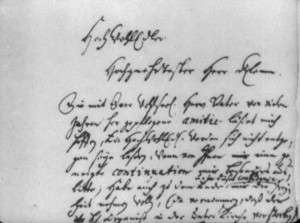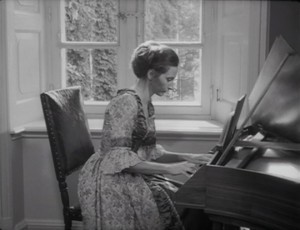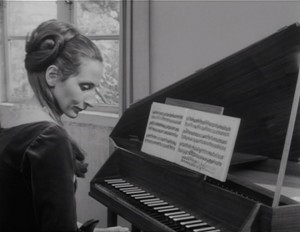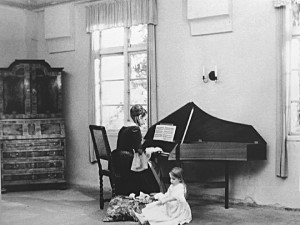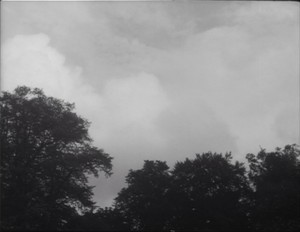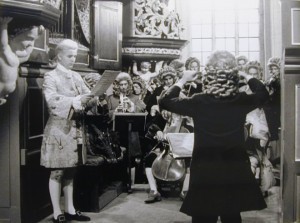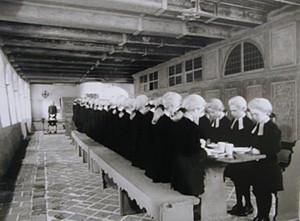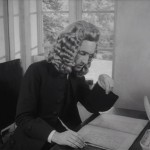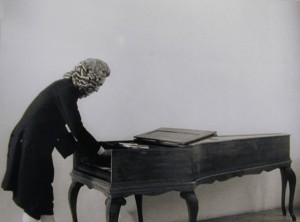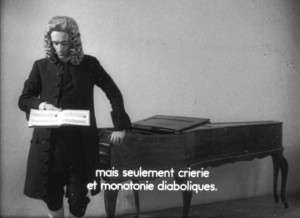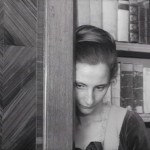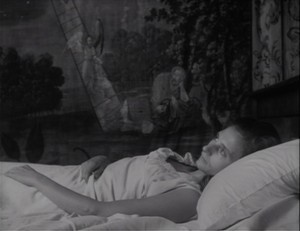[Opening credits, white text on a black]
– Chronik der Anna Magdalena Bach
– By Danièle Huillet and Jean-Marie Straub
– With Gustav Leonhardt [Johann Sebastian Bach], Christiane Lang-Drewanz [Anna Magdalena Bach]
– Paolo Carlini [Dr. Hölzel, advisor], Ernst Castelli [Steger, court advisor], Hans-Peter Boye [Born, advisor to the religious chapter], Joachim Wolf [rector], Rainer Kirchner [superintendent], Eckart Brüntjen [Kittler, choir prefect], Walter Peters [Krause, choir prefect], Kathrien Leonhardt [Catharina Dorothea Bach], Anja Fährmann [Regina Susanna Bach], Katja Drewanz [Christiana Sophia Henrietta Bach]
– Bob van Asperen [Johann Elias Bach], Andreas Pangritz [Wilhelm Friedemann Bach], Bernd Weikl [singer, BWV 205], Wolfgang Schöne [singer, BWV 82], Karl-Heinz Lampe [singer, BWV 42], Christa Degler [voice of Anna Magdalena Bach for BWV 244a], Karlheinz Klein [bass of the duet BWV 140]
– Orchestras: Concentus Musicus, Ensemble für Alte Musik, Vienna; conducted by Nikolaus Harnoncourt [orchestra at the court of Cöthen, with Nikolaus Harnoncourt in the role of Prince Leopold of Anhalt-Cöthen]. Konzertgruppe der Schola Cantorum Basiliensis [Basel]; conducted by August Wenzinger [church orchestra in Leipzig]
– Choirs: Knabenchor, Hannover, conducted by Heinz Hennig [chorus of the Saint-Thomas school]. Sopranos: Bernhard Wehle of the Regensburger Domspatzen [for BWV 140]
– Costumes: “Casa d’arte Firenze,” Vera Poggioni, Renata Morroni, Wigs: “Parrucche Rocchetti,” Todero Guerrino, Harpsichords, spinet and clavichord from Martin Skowroneck, Bremen, and Carl August Gräbner, Dresden
– Image: Ugo Piccone, Saverio Diamanti, Giovanni Canfarelli, Hans Kracht (Defa), Uwe Radon (Defa), Rear projection: Thomas Hartwig
– Sound: Louis Hochet, Lucien Moreau, Sound Mix: Paul Schöler
– Main locations: Eutin (castle [Prince of Anhalt- Cöthen’s castle]); Preetz (monastery church [organ loft no. 3, Cöthen Cathedral]; Stade ([churches] St. Wilhaldi and St. Cosmae [organ loft no. 1, St. Thomas Church in Leipzig; organ loft no. 2, at the university]); Leipzig (facade of the city hall [Leipzig marketplace]); Lüneburg (Lüne Abbey [St. Thomas School: refectory, Cantor’s lodgings]); Haseldorf (castle [Cantor’s lodgings: composition room; superintendent’s
lodgings]); Lübeck (Füchting court [municipal counsel’s room, Leipzig Town Hall]); Nuremberg
(National Germanic Museum [Cantor’s lodgings: music room)]; Freiberg in Saxony (cathedral [organ loft no. 5, Notre-Dame of Dresden church]); Grosshartmannsdorf (church [organ loft no. 4, St. Sophie of Dresden church]); [East] Berlin (Opera House [“Apollo” room]). Bach’s manuscripts and original prints have been kindly placed at our disposal by the Tübingen University Library, the West German Library of Marburg, the State Library of the Stiftung Preussischer Kulturbesitz in Berlin- Dahlem, the Berlin State Library unter den Linden and by the Bach-Archiv Leipzig. We also thank professors Christhard Mahrenholz, Georg von Dadelson, Alfred Dürr, Friedrich Smend and Werner Neumann
– Technicians: Hans Eberle, Max Jörg, Walter Eder, Max Strobl, Heinz Krähnke (Defa), Peter Algert (Defa), Jürgen Zanner (Defa), Jürgen Schlobach (Defa)
– German-Italian Co-production, Franz Seitz Filmproduktion [Munich], Gianvittorio Baldi IDI Cinematografica [Rome], Straub-Huillet, Kuratorium Junger Deutscher Film [Munich], Hessischer Rundfunk [Frankfurt], Filmfonds e.V. [Rome]; Telepool [Munich]
– Production Manager: Danièle Huillet, Assistance: Georg Föcking, Aldo Passalacqua, Joachim Wolf, Horst Winter (Defa), Günter Maag (Defa)
– Editing: Danièle Huillet, For: Jacques Rivette, Jean-Luc Godard, Michel Delahaye, Peter Nestler, and many others. Jean Marie-Straub
MUSIC BY J. S. BACH: Brandenburg Concerto No. 5, BWV 1050, first movement (allegro 1), measures 147–227, harpsichord and orchestra (1720–1721) • Little ;Clavier Book for Wilhelm Friedemann Bach, BWV 128, Prelude no. 6, clavichord, 1720 • Little Clavier Book for Anna Magdalena Bach ANNO 1722, BWV 812, French Suite No. 1 in D minor, Minuet II, spinet • Sonata No. 2 in D major for Viola da Gamba and Harpsichord, BWV 1028, adagio, ca. 1720 • Organ Sonata No. 2 in C minor, BWV 526, largo, organ, 1727 • Magnificat in D major, BWV 243, no. 11 and no. 12 through measure 19 (“Sicut locutus est” and Gloria), 1728–1731 • Little Clavier Book for A.M.B., BWV 830, Tempo di gavotta of the Partita No. 6 in E minor, spinet, 1725 • Cantata BWV 205, “Der zufriedengestellte Aeolus,” recitative for bass (“Ja! ja! Die Stunden sind nunmehro nah”) and aria (“Wie will ich lustig lachen”), 1725 • Cantata BWV 198 (Funeral Ode), final chorus, 1727 • Cantata BWV 244a (Funeral music for Prince Leopold), aria “Mit Freuden sei die Welt verlassen,” measure 25 until the end, 1729 • St. Matthew’s Passion, BWV 244, opening chorus, 1727 • Cantata BWV 42, “Am Abend aber des selbigen Sabbats,” Sinfonia (da capo, measures 1 to 53) and Tenor Recitative,
1725 • Prelude and Fugue in B minor, BWV 544, 1727–1731 • Mass in B minor, BWV 232, first Kyrie eleison, measures 1–30, 1733 • Cantata BWV 215, first chorus, measures 1–181, 1734 • Ascension Oratorio, BWV 11, second part of final chorus, 1735 • Clavier-Übung III, “Kyrie, Gott heiliger Geist,” BWV 671, 1739 • Clavier-Übung II, Italian Concerto, BWV 971, andante, 1735 • Cantata BWV 140, first duo, measures 1–36, 1731 • Goldberg Variations, BWV 988, 25th variation, 1741–1742 • Cantata BWV 82, “Ich habe genug,” final recitative and final aria, 1727 • The Musical Offering, BWV 1079, Ricercar a 6, measures 1–39, harpsichord, 1747 • Art of the Fugue, BWV 1080, Contrapunctus XIX, measures 193–239, clavichord, 1750 • Choral Preludes, “Vor deinen Thron tret’ ich,” BWV 668, first part, measures 1–11, 1750. MUSIC BY LEO LEONIUS: Conventional Sunday motet (11th after Trinity) from the “Florilegium Portense” by Erhard Bodenschatz.
TEXT: Carl Philipp Emanuel Bach and J.F. Agricola, Necrology (1754), letters and memoirs by Johann Sebastian Bach and other period documents.
PRODUCTION DATES: August 20 to October 14, 1967. EQUIPMENT: 1 Mitchell BNC 300, 1 Nagra III, Neumann microphones, Kodak 4-X (5224) film stock, Rochester, USA. 28,500 m. of negative exposed.
FINAL LENGTH: 2,558 m.
BUDGET: 470,000 DM. In addition to subtitled versions, there exist 4 versions with the voice-over commentary read in different languages.
FRENCHVERSION: dialogue subtitled by Danièle Huillet, commentary read in French with a strong German accent by Christiane Lang; DUTCH VERSION: dialogue subtitled with Henk de By, commentary read in Dutch by Margret Schumacher; ITALIAN VERSION: dialogue subtitled with Adriano Aprà, commentary read in Italian with a slight German accent by Rita Ehrhardt; ENGLISH VERSION: dialogue subtitled with Misha Donat, commentary read in English with a slight German accent by Gisela Hume. FIRST SCREENING: 1968 Cinemanifestatie Utrecht (February 3); 1968 Cannes Film Festival, Critic’s Week (May); 1968 Berlin Film Festival (June 30); 1968 New York Film Festival (September 19); 1968 London Film Festival (Grand Prize); 1968 Prades Film Festival (Special Prize). German Critics’ “Bambi” Prize: Best German Film of 1968. TV PREMIERE: September 29, 1969 (HR III, West Germany).

